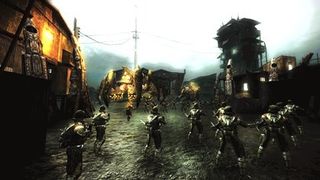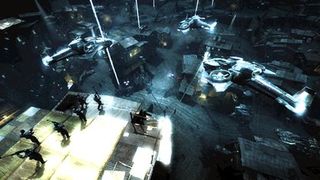You might not realize it, but every real-time strategy game you’ve played has been nothing more than prettied up chess. That’s according to Vispi Bhopti, product manager for Sega and Creative Assembly’s upcoming Stormrise. The current buzzword in gaming is ‘verticality’. It seems the next dimension is actually, well, the good old-fashioned third dimension – you know, up and down and all that. You can really see how it makes a difference in something like Stormrise. Most RTSs, including Creative Assembly’s Rome: Total War, have always existed on that one plane, and give or take the occasional hill, it was a flat plane at that.

One of Stormrise’s hooks is its attention to landscaping (there is another notable hook, more on that in a bit), and it provides the potential for a leap forward in the genre. Considering real-time strategy games are all about thinking and tactics and predicting the enemy’s next few moves, they’ve been one-dimensional, especially compared to what Stormrise could offer – in theory.
There are 12 levels in total, and the majority are massive – really massive. Big enough to support somewhere in the region of 400 units at once – all split into factions, all doing their own scrapping in different corners of each map. One was what looked like a huge concrete multi-story car park the size of Heathrow Airport, with a number of surrounding out-buildings. A sprawling map in its own right spread over about five different ‘floors’.
Part of the map was cut off by a canal with a narrow bridge connecting it to the mainland – a battleground bottleneck if ever there was one. Bhopti pointed out the possibilities for flanking and picking off patrols by swinging the camera round to reveal a sunken bunker hidden from most views, ideal for stationing a squad and letting them sit and erase lone stragglers trying to make it across the bridge. He also showed how just a couple of jet-packed troopers stationed on top of an abandoned factory could sweep the expanse of ground in front of the bridge and cover their comrades crossing the canal. There were numerous possibilities – far too many to list. The sort of thing to give you a splitting headache. The sort of thing that strategy fans go mad for.

Another map was a full city, complete with multiple skyscrapers and a harbour with an island in the centre of it. That was enough to be getting on with, but then Bhopti dropped the camera through the ground to reveal an intricate network of subterranean tunnels. The ideal place to build a crushing army totally undetected. This map was also our introduction to the Sai airborne creatures – as Bhopti termed one, “the flying chicken” (a huge dragon with half a dozen weird dumpy chicken legs) – capable of hovering and delivering a fire storm on demand. Needless to say they’re dangerous; hence the value of the underground caverns.
